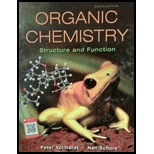
(a)
Interpretation:The product formed in indicated reaction should be formulated and whether it is chiral and shows any optical activity or not should be determined.

Concept introduction: The carbonyl bond is polar with partial positive charge on carbon and partial negative charge on oxygen as illustrated below.
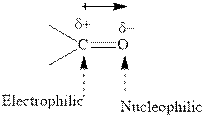
Thus it can undergo hydride addition at carbon and proton addition at oxygen. Certain reagents that are useful for such hydride addition at carbonyl carbon include
Optical activity refers to ability to rotate the plane polarized light. For example, if the light is passed through a substance and the light that emerges has radiations are confined to one plane only the substance is said to be optically active.
The earliest criteria for optical activity were presence of a chiral center. The chiral refer to species attached to four different substituents. Chiral center leads to existence of organic compounds as two enantiomeric forms. However chiral center alone is not sufficient condition for determination of optical activity.
The criteria to identify the optical activity are to look for absence of any symmetry element. The symmetry elements make any molecule optically inactive.
(b)
Interpretation: The product formed in indicated reaction should be formulated and whether it is chiral and shows any optical activity or not should be determined.

Concept introduction: The carbonyl bond is polar with partial positive charge on carbon and partial negative charge on oxygen as illustrated below.
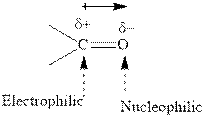
Thus it can undergo hydride addition at carbon and proton addition at oxygen. Certain reagents that are useful for such hydride addition at carbonyl carbon include
Optical activity refers to ability to rotate the plane polarized light. For example, if the light is passed through a substance and the light that emerges has radiations are confined to one plane only the substance is said to be optically active.
The earliest criteria for optical activity were presence of a chiral center. The chiral refer to species attached to four different substituents. Chiral center leads to exists of organic compounds as two enantiomeric forms. However chiral center alone is not sufficient condition for determination of optical activity.
The criteria to identify the optical activity are to look for absence of any symmetry element. The symmetry elements make any molecule optically inactive.
(c)
Interpretation: The product formed in indicated reaction should be formulated and whether it is chiral and shows any optical activity or not should be determined.

Concept introduction:The carbonyl bond is polar with partial positive charge on carbon and partial negative charge on oxygen as illustrated below.
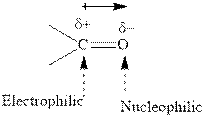
Thus it can undergo hydride addition at carbon and proton addition at oxygen. Certain reagents that are useful for such hydride addition at carbonyl carbon include
Optical activity refers to ability to rotate the plane polarized light. For example, if the light is passed through a substance and the light that emerges has radiations are confined to one plane only the substance is said to be optically active.
The earliest criteria for optical activity were presence of a chiral center. The chiral refer to species attached to four different substituents. Chiral center leads to exists of organic compounds as two enantiomeric forms. However chiral center alone is not sufficient condition for determination of optical activity.
The criteria to identify the optical activity are to look for absence of any symmetry element. The symmetry elements make any molecule optically inactive.
(d)
Interpretation: The product formed in indicated reaction should be formulated and whether it is chiral and shows any optical activity or not should be determined.

Concept introduction:The carbonyl bond is polar with partial positive charge on carbon and partial negative charge on oxygen as illustrated below.
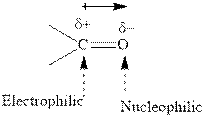
Thus it can undergo hydride addition at carbon and proton addition at oxygen. Certain reagents that are useful for such hydride addition at carbonyl carbon include
Optical activity refers to ability to rotate the plane polarized light. For example, if the light is passed through a substance and the light that emerges has radiations are confined to one plane only the substance is said to be optically active.
The earliest criteria for optical activity were presence of a chiral center. The chiral refer to species attached to four different substituents. Chiral center leads to exists of organic compounds as two enantiomeric forms. However chiral center alone is not sufficient condition for determination of optical activity.
The criteria to identify the optical activity are to look for absence of any symmetry element. The symmetry elements make any molecule optically inactive.
Want to see the full answer?
Check out a sample textbook solution
Chapter 8 Solutions
EBK ORGANIC CHEMISTRY
- Please analze my gel electrophoresis column of the VRK1 kinase (MW: 39.71 kDa). Attached is the following image for the order of column wells and my gel.arrow_forward2.0arrow_forwardWrite the electron configuration of an atom of the element highlighted in this outline of the Periodic Table: 1 23 4 5 6 7 He Ne Ar Kr Xe Rn Hint: you do not need to know the name or symbol of the highlighted element! ☐arrow_forward
- Compare these chromatograms of three anti-psychotic drugs done by HPLC and SFC. Why is there the difference in separation time for SFC versus HPLC? Hint, use the Van Deemter plot as a guide in answering this question. Why, fundamentally, would you expect a faster separation for SFC than HPLC, in general?arrow_forwardA certain inorganic cation has an electrophoretic mobility of 5.27 x 10-4 cm2s-1V-1. The same ion has a diffusion coefficient of 9.5 x 10-6cm2s-1. If this ion is separated from cations by CZE with a 75cm capillary, what is the expected plate count, N, at an applied voltage of 15.0kV? Under these separation conditions, the electroosmotic flow rate was 0.85mm s-1 toward the cathode. If the detector was 50.0cm from the injection end of the capillary, how long would it take in minutes for the analyte cation to reach the detector after the field was applied?arrow_forward2.arrow_forward
- Please solve for the following Electrochemistry that occursarrow_forwardCommercial bleach contains either chlorine or oxygen as an active ingredient. A commercial oxygenated bleach is much safer to handle and less likely to ruin your clothes. It is possible to determine the amount of active ingredient in an oxygenated bleach product by performing a redox titration. The balance reaction for such a titration is: 6H+ +5H2O2 +2MnO4- à 5O2 + 2Mn2+ + 8H2O If you performed the following procedure: “First, dilute the Seventh Generation Non-Chlorine Bleach by pipetting 10 mL of bleach in a 100 mL volumetric flask and filling the flask to the mark with distilled water. Next, pipet 10 mL of the diluted bleach solution into a 250 mL Erlenmeyer flask and add 20 mL of 1.0 M H2SO4 to the flask. This solution should be titrated with 0.0100 M KMnO4 solution.” It took 18.47mL of the KMnO4 to reach the endpoint on average. What was the concentration of H2O2 in the original bleach solution in weight % assuming the density of bleach is 1g/mL?arrow_forward10.arrow_forward
- Proper care of pH electrodes: Why can you not store a pH electrode in distilled water? What must you instead store it in? Why?arrow_forwardWrite the electron configuration of an atom of the element highlighted in this outline of the Periodic Table: 1 23 4 569 7 He Ne Ar Kr Xe Rn Hint: you do not need to know the name or symbol of the highlighted element! §arrow_forwardIdentify the amino acids by name. Illustrate a titration curve for this tetrapeptide indicating the pKa's for each ionizable groups and identify the pI for this tetrapeptide. please helparrow_forward
 Chemistry: The Molecular ScienceChemistryISBN:9781285199047Author:John W. Moore, Conrad L. StanitskiPublisher:Cengage Learning
Chemistry: The Molecular ScienceChemistryISBN:9781285199047Author:John W. Moore, Conrad L. StanitskiPublisher:Cengage Learning Organic ChemistryChemistryISBN:9781305580350Author:William H. Brown, Brent L. Iverson, Eric Anslyn, Christopher S. FootePublisher:Cengage Learning
Organic ChemistryChemistryISBN:9781305580350Author:William H. Brown, Brent L. Iverson, Eric Anslyn, Christopher S. FootePublisher:Cengage Learning Chemistry & Chemical ReactivityChemistryISBN:9781337399074Author:John C. Kotz, Paul M. Treichel, John Townsend, David TreichelPublisher:Cengage Learning
Chemistry & Chemical ReactivityChemistryISBN:9781337399074Author:John C. Kotz, Paul M. Treichel, John Townsend, David TreichelPublisher:Cengage Learning
 Chemistry & Chemical ReactivityChemistryISBN:9781133949640Author:John C. Kotz, Paul M. Treichel, John Townsend, David TreichelPublisher:Cengage Learning
Chemistry & Chemical ReactivityChemistryISBN:9781133949640Author:John C. Kotz, Paul M. Treichel, John Townsend, David TreichelPublisher:Cengage Learning




